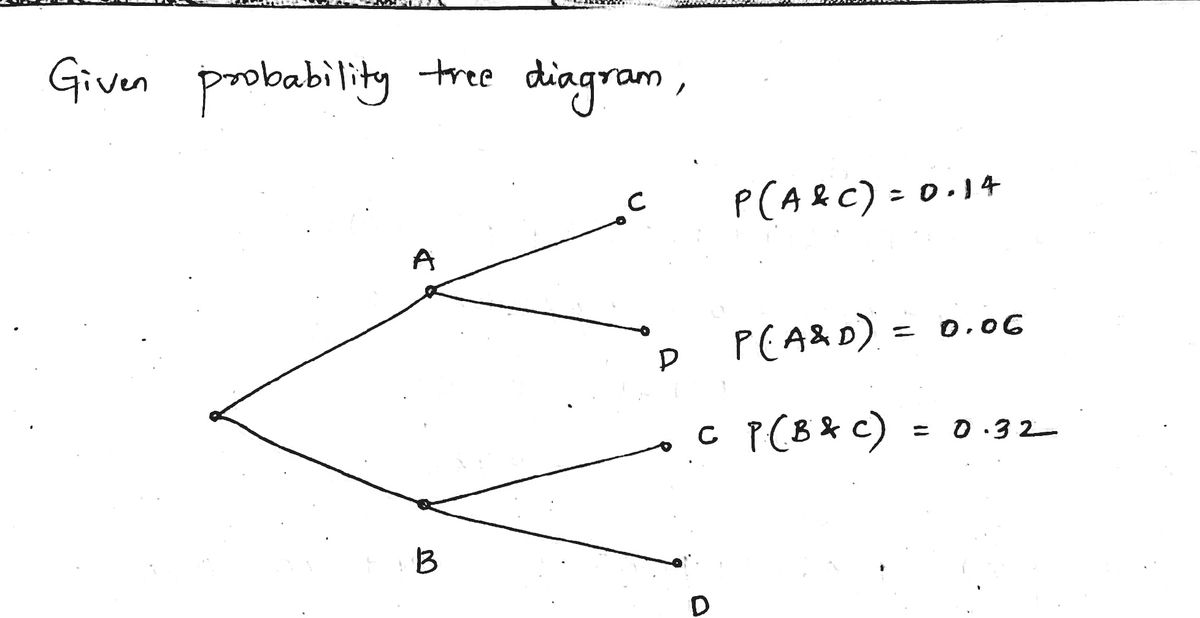In the probability tree diagram below, the numbers represent positions where certain probabilities are written. 1 C 7. 10. We are given the following probabilities. P(A & C) = 0.14 P(A & D) = 0.06 P(B & C) = 0.32 4. (No Response) X 5. (No Response) X 6. (No Response) X 7. (No Response) X 8. (No Response) X 9. (No Response) X 10. (No Response) X Use the properties of probability trees to complete the tree. Enter the number of the probabilities for each position of the tree. 1. (No Response) X 2. (No Response) X 3. (No Response) X
In the probability tree diagram below, the numbers represent positions where certain probabilities are written. 1 C 7. 10. We are given the following probabilities. P(A & C) = 0.14 P(A & D) = 0.06 P(B & C) = 0.32 4. (No Response) X 5. (No Response) X 6. (No Response) X 7. (No Response) X 8. (No Response) X 9. (No Response) X 10. (No Response) X Use the properties of probability trees to complete the tree. Enter the number of the probabilities for each position of the tree. 1. (No Response) X 2. (No Response) X 3. (No Response) X
A First Course in Probability (10th Edition)
10th Edition
ISBN:9780134753119
Author:Sheldon Ross
Publisher:Sheldon Ross
Chapter1: Combinatorial Analysis
Section: Chapter Questions
Problem 1.1P: a. How many different 7-place license plates are possible if the first 2 places are for letters and...
Related questions
Question
![**Using Probability Tree Properties to Complete a Tree**
In the probability tree diagram below, the numbers represent positions where certain probabilities are written.
[Diagram of a probability tree]
- The tree starts with an initial branch that splits into two: A and B.
- From A, there are two branches leading to C and D.
- From B, there are also two branches leading to C and D.
- Each branch is numbered 1 to 10, representing positions for probabilities.
We are given the following probabilities:
- P(A & C) = 0.14
- P(A & D) = 0.06
- P(B & C) = 0.32
**Task:**
Use the properties of probability trees to complete the tree. Enter the value of the probabilities for each position of the tree.
1. (No Response) ❌
2. (No Response) ❌
3. (No Response) ❌
4. (No Response) ❌
5. (No Response) ❌
6. (No Response) ❌
7. (No Response) ❌
8. (No Response) ❌
9. (No Response) ❌
10. (No Response) ❌](/v2/_next/image?url=https%3A%2F%2Fcontent.bartleby.com%2Fqna-images%2Fquestion%2F05306099-d17b-4786-a552-6aca0323abbc%2Fc980ead8-4305-4f60-8f0d-39341ae1ee9d%2Fik09xbu_processed.jpeg&w=3840&q=75)
Transcribed Image Text:**Using Probability Tree Properties to Complete a Tree**
In the probability tree diagram below, the numbers represent positions where certain probabilities are written.
[Diagram of a probability tree]
- The tree starts with an initial branch that splits into two: A and B.
- From A, there are two branches leading to C and D.
- From B, there are also two branches leading to C and D.
- Each branch is numbered 1 to 10, representing positions for probabilities.
We are given the following probabilities:
- P(A & C) = 0.14
- P(A & D) = 0.06
- P(B & C) = 0.32
**Task:**
Use the properties of probability trees to complete the tree. Enter the value of the probabilities for each position of the tree.
1. (No Response) ❌
2. (No Response) ❌
3. (No Response) ❌
4. (No Response) ❌
5. (No Response) ❌
6. (No Response) ❌
7. (No Response) ❌
8. (No Response) ❌
9. (No Response) ❌
10. (No Response) ❌
Expert Solution
Step 1: Analysing the given data

Step by step
Solved in 3 steps with 2 images

Recommended textbooks for you

A First Course in Probability (10th Edition)
Probability
ISBN:
9780134753119
Author:
Sheldon Ross
Publisher:
PEARSON


A First Course in Probability (10th Edition)
Probability
ISBN:
9780134753119
Author:
Sheldon Ross
Publisher:
PEARSON
